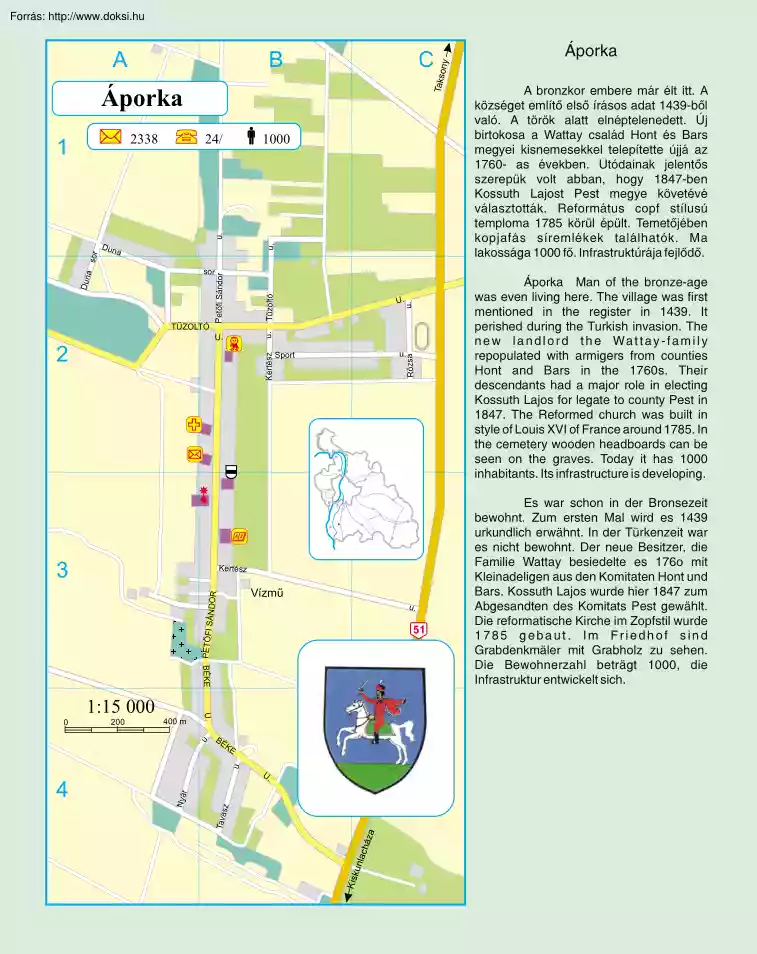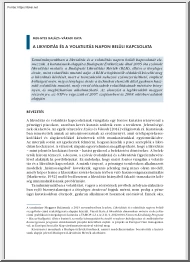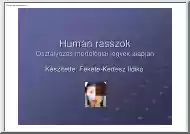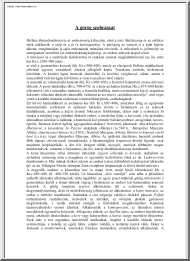Értékelések
Nincs még értékelés. Legyél Te az első!
Mit olvastak a többiek, ha ezzel végeztek?
Tartalmi kivonat
A C Takso ny B Áporka 2338 24/ 1000 u. Dun a Tûzoltó 3 u. u. Sport Rózsa U. Kertész 2 U. u. TÛZOLTÓ Petõfi Sándor sor Dun a sor u. 1 Kertész NDOR Vízmû PETÕFI SÁ u. 51 BÉKE U. chá za Tava sz 4 Nyár u. BÉ KE unla 400 m u. 200 Kisk 1:15 000 U. 0 Áporka A bronzkor embere már élt itt. A községet említõ elsõ írásos adat 1439-bõl való. A török alatt elnéptelenedett Új birtokosa a Wattay család Hont és Bars megyei kisnemesekkel telepítette újjá az 1760- as években. Utódainak jelentõs szerepük volt abban, hogy 1847-ben Kossuth Lajost Pest megye követévé választották. Református copf stílusú temploma 1785 körül épült. Temetõjében kopjafás síremlékek találhatók. Ma lakossága 1000 fõ. Infrastruktúrája fejlõdõ Áporka Man of the bronze-age was even living here. The village was first mentioned in the register in 1439. It perished during the Turkish invasion. The n e w l a n d l o r d
t h e Wa t t a y - f a m i l y repopulated with armigers from counties Hont and Bars in the 1760s. Their descendants had a major role in electing Kossuth Lajos for legate to county Pest in 1847. The Reformed church was built in style of Louis XVI of France around 1785. In the cemetery wooden headboards can be seen on the graves. Today it has 1000 inhabitants. Its infrastructure is developing Es war schon in der Bronsezeit bewohnt. Zum ersten Mal wird es 1439 urkundlich erwähnt. In der Türkenzeit war es nicht bewohnt. Der neue Besitzer, die Familie Wattay besiedelte es 176o mit Kleinadeligen aus den Komitaten Hont und Bars. Kossuth Lajos wurde hier 1847 zum Abgesandten des Komitats Pest gewählt. Die reformatische Kirche im Zopfstil wurde 1785 gebaut. Im Friedhof sind Grabdenkmäler mit Grabholz zu sehen. Die Bewohnerzahl beträgt 1000, die Infrastruktur entwickelt sich
t h e Wa t t a y - f a m i l y repopulated with armigers from counties Hont and Bars in the 1760s. Their descendants had a major role in electing Kossuth Lajos for legate to county Pest in 1847. The Reformed church was built in style of Louis XVI of France around 1785. In the cemetery wooden headboards can be seen on the graves. Today it has 1000 inhabitants. Its infrastructure is developing Es war schon in der Bronsezeit bewohnt. Zum ersten Mal wird es 1439 urkundlich erwähnt. In der Türkenzeit war es nicht bewohnt. Der neue Besitzer, die Familie Wattay besiedelte es 176o mit Kleinadeligen aus den Komitaten Hont und Bars. Kossuth Lajos wurde hier 1847 zum Abgesandten des Komitats Pest gewählt. Die reformatische Kirche im Zopfstil wurde 1785 gebaut. Im Friedhof sind Grabdenkmäler mit Grabholz zu sehen. Die Bewohnerzahl beträgt 1000, die Infrastruktur entwickelt sich




